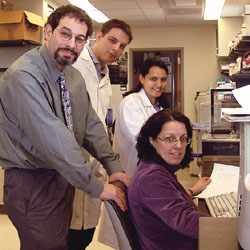‘Ions are the currency of the cellular world:’ What controls ion flow inside cells also controls outside flow
By John EastonMedical Center Public Affairs
 Professor Steven Goldstein (left to right) meets with his research team Leigh Plant, Sindhu Rajan and Margaret Butler. Plant and Rajan are co-first authors of the study on sumoylation. | |
Researchers at the University have found that a recently discovered biological process known as sumoylation—until now thought to be active only in a cell’s nucleus—also occurs near a cell’s surface.
The discovery, published in the Friday, April 8 issue of the journal Cell, answers a question dating back to the 1950s: How do cells control the background movement of potassium ions across the cell membrane? This process is important because the flow of potassium ions determines whether “excitable” cells in the brain, heart and skeletal muscles “fire,” sending out nerve impulses that become thoughts, heartbeats and basketball dunks.
Furthermore, as the sumoylation process regulates at least one and possibly many kinds of proteins at the cell’s surface, the researchers’ discovery provides a novel target for the development of new drugs.
“We found that a little-studied process called sumoylation, previously associated with nuclear proteins, is active and essential outside the nucleus at the plasma membrane,” said study author Steven Goldstein, Professor and Chairman of Pediatrics and Director of the Institute for Molecular Pediatric Sciences at the University. “This adds a new chapter to the book of how cells control ion channel function: reversible peptide linkage.”
Ion channels, which are in every cell in the human body, are tightly controlled tunnels through the membrane barriers, holding in the cell’s contents and separating it from the outside world. Ion channels allow such ions as potassium, sodium and calcium to flow in and out, and so are key regulators of many fundamental biological processes.
“Ions are the currency of the cellular world,” said Goldstein. “Cells collect some ions, others they discharge. Ions are stored, spent and exchanged.”
“Cellular solvency,” he added, “the ability to respond to the stimuli that are life, is all about the balance between ions inside and outside each cell. The gradual doling out or sudden influx of ions through ion channels are the basis for those cellular activities that give us thoughts, sights, tastes, sounds and our ability to move.
“Consequently, cells control these actions as carefully as we watch our finances,” he added, “which is why so many of the most potent medications we use to care for our patients target one or another ion channel.”
Goldstein’s team discovered the type of ion channel known as background (or leak) potassium channels in yeast cells in 1995, and in fruit flies in 1996. Although potassium leak was first described in the 1950s when it was recognized to control excitation of nerves, the reason for leak had not been understood.
The first human clone of this channel, K2P1, generated a good deal of excitement, Goldstein said, but no one could learn much about it because it always seemed to be mute. “This discouraged a lot of people.”
The problem was that some hidden mechanism was silencing the channel, plugging the pipeline, but no known method of channel regulation seemed to be involved.
Goldstein and colleagues began to suspect sumoylation, a process in which an enzyme attaches a small peptide called SUMO (for small ubiquitin-like modifier protein) onto another protein. The presence of SUMO alters how the second protein functions.
Goldstein’s team first demonstrated that the SUMO-conjugating enzyme was plentiful at the plasma membrane, just inside the cell surface. They next showed it added SUMO to a specific part of the K2P1 channel and that when this happened, the channel was entirely silent. When a different enzyme removed the SUMO tag, however, ions began to stream through the channel.
Understanding the role of sumoylation allowed the team to study the K2P1 channel for the first time. They found it is open at rest and closed when the SUMO tag is attached. When it is closed, potassium ions build up within the cell. When they reach a threshold level, the cell is primed for activity, such as transmitting a nerve impulse.
Sumoylation recently has been recognized as an important mechanism of cellular activity, but until now, its near-60 known targets were primarily nuclear proteins, mostly involved in gene transcription. “The findings expand the influence of SUMO-related activity in biology,” Goldstein said, “a great and exciting surprise.”
“There is still a good deal we don’t understand about this system,” he said, “but now we know where to look and why we must go there. SUMO may very well act on other ion channels that have yet to reveal their function because they were silent like K2P1.”
SUMO may also control other membrane proteins key to biology, such as transporters and hormone receptors, because the binding site is present in these proteins, although not yet proven to operate.
“Cells are fastidious in the way they regulate activity at their borders,” Goldstein added. “Our work shows how sumoylation controls one important process at the cell surface and hints that it may influence others.”
Sindhu Rajan and Leigh Plant, co-first authors, and Michael Rabin and Margaret Butler, all of the Institute for Molecular Pediatric Sciences at the University, contributed to the study and its findings. “I am proud of the team,” Goldstein emphasized. “They are remarkable collaborators, deeply dedicated and just plain smart.”
![[Chronicle]](/images/sidebar_header_oct06.gif)